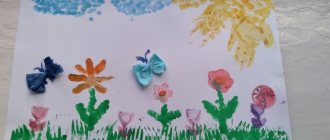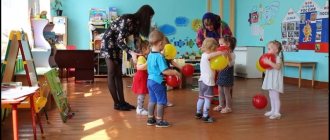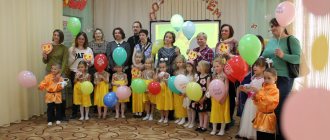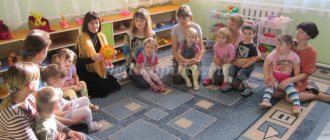Long-term entertainment plan for the first junior group
Entertainment plan for the first junior group
September
- "Guys' Holiday"
Goal: to put children in a good mood by listening and singing along to children's songs from cartoons. Offer to move to the music with handkerchiefs and rattles.
- "Funny toys"
Goal: developing children's knowledge about caring for toys and handling them correctly; learn to answer questions based on the text; create a good mood, a positive emotional state; enrich your vocabulary.
- Video library. Fairy tale "Ryaba Hen"
Goal: to put children in a good mood from watching a presentation of a fairy tale. Learn to answer questions. Offer to mold the grains for the chicken. Cultivate a love for Russian folklore.
- physical education "Visiting the bear"
Goal: to exercise children in walking and running. Improve crawling and jumping skills. Continue to expand children's knowledge about autumn. Give children a feeling of joy.
October
1. “Visiting the bear”
Goal: to exercise children in walking and running. Improve crawling and jumping skills. Continue to expand children's knowledge about autumn. Give children a feeling of joy.
2.
Video library.
Fairy tale “Turnip” Purpose: to put children in a good mood from watching the presentation of the fairy tale. Learn to answer questions. Offer to build a path of bricks for the woman and grandfather.
3. Musical and theatrical “Cat with Kittens”
Goal: to make children want to emotionally interact with adults. Encourage children to actively participate in the activity. Continue to introduce the habits of cats and kittens.
- Musical and theatrical “The doll Masha has a birthday”
Goal: to help children remember the sequence of dressing and feeding. Continue introducing the names of cookware. Develop interest in play. Cultivate a caring attitude towards the doll.
November
- Physical education "Our Teremok"
(Kolesnikova, p. 24) Purpose: To train children in running and jumping; stimulate speech activity. Foster a love of playing together.
(Kolesova, p. 24)
- Cognitive and research “Who came to visit?”
Goal: To awaken children's interest in small folk forms of oral folk art. Involve children in communication with adults and peers. Develop children's individual creative abilities through modeling. Consolidate knowledge of familiar nursery rhymes.
- Musical and theatrical "Russian Matryoshka"
Goal: To introduce children to Russian folk art using the example of folk toys. Evoke positive emotions. Encourage participation in games and round dances.
- “The kids congratulate mom”
Goal: To enrich children's musical experience. Create a joyful mood in them. Develop the ability to move rhythmically to music.
December
- Physical education and recreation “My funny ringing ball”
Goal: To develop endurance, muscle strength, and agility in children. Exercise children in performing movements with the ball. Act on a signal. Give children pleasure.
- Video library “Christmas tree in the forest”
Goal: To make children want to see a Christmas tree in the forest (using slides). Make you want to sing along to the song “Little Christmas Tree”. Develop musicality and sense of rhythm.
- Educational and research “Winter walk”
Goal: To consolidate children's knowledge about the winter season. Develop cognitive activity: find snow, ice. Learn to perform movements to music. Develop a sense of rhythm
- “Santa Claus brought a Christmas tree for the children”
January
- Physical education and recreation “Outdoors in winter”
Goal: to give children pleasure from playing outdoors. Exercise children in jumping up while reaching for an object. Develop the ability to throw snowballs into the distance with your right and left hands. Practice balance (stop quickly when given a signal). Develop dexterity and patience.
- Musical and theatrical “Farewell to the Christmas tree”
Goal: To make children want to have fun at the Christmas tree: sing songs, dance, play
- Educational and research “Pills grow on a branch, pills grow in a garden bed.”
Goal: To clarify children’s knowledge about vegetables and fruits, their qualities, to consolidate the ability to recognize them from a picture and give a short description.
February
- Musical and theatrical "About the red fox"
Goal: to make children want to sing and play with a fairy-tale character, to participate in the staging of the nursery rhyme “Once a fox went into the forest.” Develop perception, speech, communication skills
- "Funny toys."
Goal: to develop children’s knowledge about caring for toys and handling them correctly; learn to answer questions based on the text; create a good mood, a positive emotional state; enrich your vocabulary.
- “Visiting Alyonushka”
Goal: Continue to introduce children to Russian folklore. Make children want to play on wooden spoons and admire their beauty. Develop musical and rhythmic movements.
- Physical education “The locomotive hummed”
Goal: To develop in children the ability to play outdoor games, run fast, jump, and throw balls into the distance. Be dexterous and brave.
March
- Musical and theatrical Festival “Congratulations to Mommy”
Goal: to make children want to sing, play, have fun and congratulate their mother. Develop emotional responsiveness, enrich musical experience.
- Musical and theatrical “Grandma Arina came to visit us”
»
Goal: Create an atmosphere of joyful mood. Teach children to solve riddles, read poems and sing songs together with a fairy-tale character.
- Educational and research "Rainbow Holiday"
Goal: to bring joy to children, to cause a storm of emotions. Development of dexterity, coordination of movements, the ability to distinguish colors and the size of the number of objects (soap bubbles).
- Physical education "Visiting a fairy tale"
Goal: To make children want to be participants in fairy-tale events. Develop the ability to maintain a stable body position and correct posture;
April
- Musical and theatrical "April Fool's Day"
Goal: to evoke positive emotions, good mood. Teach children to play outdoor games together, jump, run, without bumping into each other. Develop perception, coordination of movements, dexterity.
- Sports and recreational “Visiting the Hedgehog”
Purpose: to exercise children in walking and running; improve crawling and jumping skills; continue to expand children's knowledge about nature; give children a feeling of joy.
- Presentation of the fairy tale
“Kolobok”
Goal: to put children in a good mood from watching a presentation of a fairy tale. To teach them to answer questions. Offer to mold the grains for the chicken. Cultivate a love for Russian folklore.
- Cognitive and research “And on the hands there are fingers, girls and boys”
Goal: To involve children in communication with adults and peers. Develop children's individual creative abilities through modeling. Consolidate knowledge of familiar nursery rhymes.
May
- Musical and theatrical "Sunny Bunnies"
Goal: Develop communication skills. Continue to introduce basic rules of conduct, ethics of greeting and communication.
- Physical education and recreation “We grow healthy”
Goal: To evoke in children an emotional response to the gaming activity and a desire to participate in it. Teach children to play together. Teach more dexterous children to help other kids.
Teach children to sympathize and empathize with a fairy-tale character.
- Video library Fairy tale “Turnip”
Goal: to put children in a good mood from watching a presentation of a fairy tale. Learn to answer questions. Offer to build a bridge and a path to the woman and grandfather's house.
- Educational and research "Circus"
Goal: To learn to identify the features of objects and natural objects based on the techniques of sensory examination, comparison, elementary analysis and generalization. To promote mastery of various actions with objects. To promote the development of interest in participating in game improvisations.
Entertainment for toddlers “Visiting the Sun” material on the topic
Teacher Guseva T.V.
Entertainment scenario for kindergarten children
“We’re calling the Sun for a visit”
2015
Goal: To create a joyful mood in children.
Tasks:
- Develop the ability to move to music, combine movements with the words of the text
- Develop speech and emotional sensitivity to works of folklore
- Develop communication skills.
Preliminary work: Observing the sun, reading works of art and nursery rhymes, playing outdoor games.
Host: Hello, my guys. Presenter: Children love summer very much. In summer there is a lot of sun and light. Sun, sun, warm up! The holiday will be more fun!
Presenter: Let's call the Sun to us. Exercise “Sun” Bucket Sun, (pulling raised hands up) Look out the window. (make a “window”, right and left hands in parallel) Red, dress up, (“flashlights”) Show yourself clearly! (pulling raised hands up)
Sunny enters. Sunny: Hello, my friends! Did you call me? Here I am! Presenter: Hello, bell sun.
Sunny: I, the sun, have a hundred worries: Heat your garden, Bloom all the flowers, Stay on the veranda, After a downpour, on the run, Make a rainbow-arc. And throw hemp on Natasha the Laughing One’s nose.
Host: Yes, Sunny, you really have a lot to worry about - You warm the whole world and you don’t know fatigue!
Sun. In the morning the sun rises: It calls everyone to go for a walk: Get ready, dress up, smile more cheerfully! Exercise “In the morning the sun rises” (i.e. children squat)
In the morning the sun rises - slowly rise, raise your arms up through the sides Higher, higher, higher. By night the sun sets - slowly lower down, squatting Lower, lower, lower!
Okay, okay - clap your hands. The sun laughs. And everyone has fun under the sun! (music sounds - children jump on the spot)
Sunny: Tell me, guys, which one of you starts the day with exercise?
Host: Our kids start the day with exercises. We will now tell you and show you with the movements the Dance “Exercise for Kids”
Sunny: We did our exercises in the morning, everyone ate porridge, and now I invite you to take a ride on the solar carousel. Game “Carousels”
(Sunny takes a hoop to which yellow ribbons are tied and stands in the center of the hoop. Each child holds on to a ribbon and a game is played)
Barely, barely, barely - they walk slowly in a circle. The carousels are spinning. And then, then, then - they speed up the pace. Everyone runs, runs, runs. Hush, hush, the movements gradually slow down. Don’t rush, stop the carousel. One and two, one and two - they go slowly. So the game is over. - stop
Presenter: The sun is shining through our window, quickly take the rattles in your hands. Exercise with rattles “In the morning the sun woke up” Sun: Starting a new day - I, friends, am not too lazy to shine, The sun rises in the sky, Calls everyone to have fun. Presenter: It happens at It's a sunny day off, it's pouring rain outside. We won’t go for a walk - We’d rather sing a song! Song “Song about the rain” (a phonogram of rain sounds) Presenter: Apparently, we can’t wait out the rain, We’ll go for a walk now. We’ll take an umbrella with us so we don’t get wet in the rain. Dance “Walk under an umbrella”
Sunny: The sun and the cloud started playing hide and seek again. As soon as the sun hides, Cloud will burst into tears. And when the sun appears, a rainbow laughs in the sky.
Game "Sun and Rain"
Part 1 - children sing a song to the music, clap their hands Part 2 (rain music) - the teacher opens the umbrella, the children run and hide from the rain under the umbrella
Sunny: I had a lot of fun with you, but it’s time to return home to heaven. Host: Thank you, sunshine, for playing with us. It’s very good, warm, fun to be with you. Look out your window more often, warming us with your warmth. Presenter: Dear “Sun”, Shine brighter for us! You and I, “Sunny,” Together along the way. Sunny: Goodbye, friends!
Host: Goodbye, Sunny! Children, say goodbye to Sunny.
What do toys need?
All children love toys. A fun and exciting competition with your favorite friends. Each participant has the same row of toys in front of them, for example, a baby doll, a bear, a bunny, a car without a wheel, and so on. In general, everything that can be selected from the assortment of your own and borrowed toys. The point is that for each toy there will be an addition or a missing element, for example, for a baby doll - a pacifier, for a bear - a barrel of honey (a jar with the word “HONEY” written on it), for a bunny a carrot, for a car a wheel, and so on. So, the toys are in front of the participants, and on the command “start” the children each receive a bag with missing or complementary elements and distribute these parts among the toys. Whoever distributes everything faster and correctly will win.
Apchhi
Everyone can participate in turn. The first person to come is invited and is blindfolded. Then the host points his finger at any guest, and he must imitate “apchhi” - sneeze. And the participant with his eyes closed must recognize the sneezing person by this sound and say his name, then the host points his finger at the other guest, he sneezes, the participant guesses, and so on 3 more times. The number of sneezes the participant can guess is how many points he will receive. Then the next participant is invited to participate. For him, too, 5 different guys take turns sneezing. And the participant guesses them by the sound “apchhi”. And in the end, the participant with the most points will be the winner.
Heels and toes
The guys are divided into equal numbers of team members. Each team stands in a separate row (one after the other). At the same distance from each team there is a chair with the same number of candies (the number of candies is equal to the number of team members). The presenter explains a simple rule: the first participants run on their toes, the second - on their heels, the third on their toes, the fourth - on their heels, and so on through one on their toes - on their heels. At the command “start”, the first participants run on their tiptoes to their chair, take the candy and run back to their team, pass the baton to the second participants and stand at the end of the team. Then the second participants run, only on their heels, take the candy and back to their team, pass the baton and stand at the end of the team. The team that runs faster than the rest on their toes and heels and collects all their candies, and the first participant in the team will again be in first place and become the winner.
Dump truck
For this competition, you will need to provide each participant with a dump truck (you can buy identical small cars in a children's toy store). Near each participant there will be an identical pile of candies, for example. Each participant, at the command “start,” puts one candy in the back and carries it in the car along the floor to his mark (on the same line for everyone). Then he unloads the candy and goes for the next one. The first participant to transport all the candies on a dump truck will win and receive a prize.



